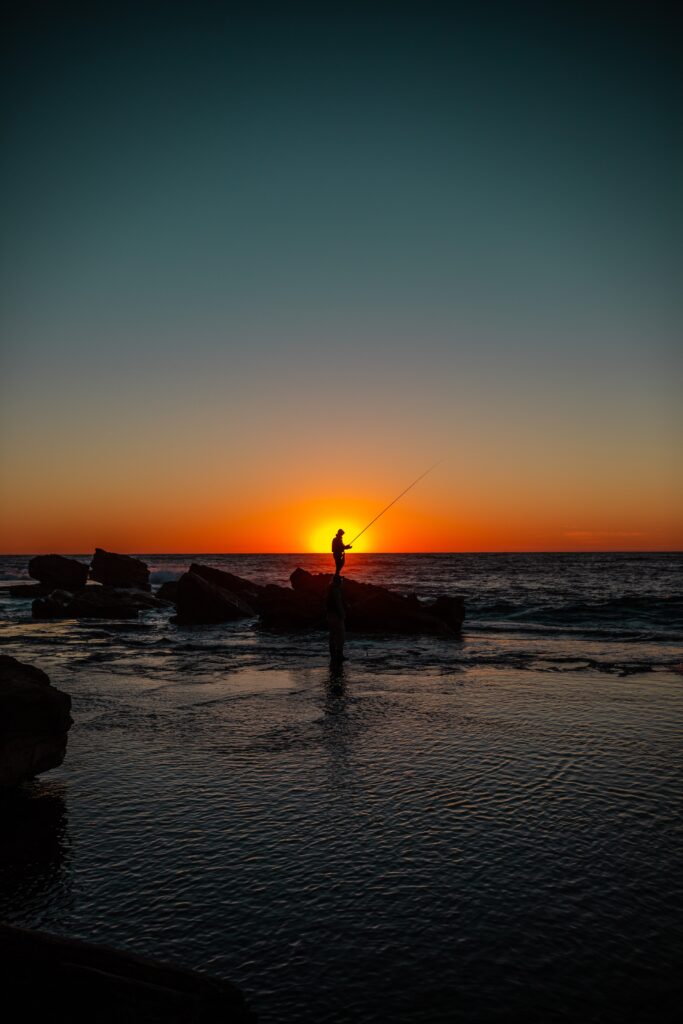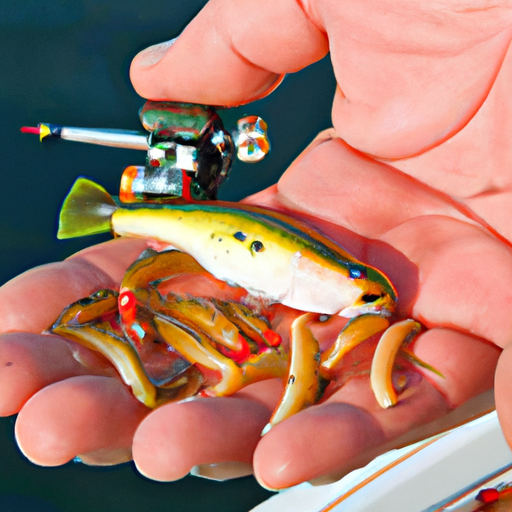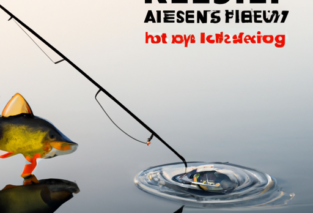Are you a beginner in the world of fishing? If so, then “The Beginner’s Guide To Fishing With Live Baits” is the perfect tool to help you get started! This comprehensive guide is designed specifically for beginners and will walk you through everything you need to know about fishing with live baits. From choosing the right bait to casting techniques, this guide has got you covered. Say goodbye to empty hooks and hello to a successful fishing adventure with “The Beginner’s Guide To Fishing With Live Baits!

Choosing the Right Live Bait
When it comes to fishing with live baits, choosing the right bait can make all the difference in your success. There are various options available, each with its own advantages and disadvantages. Understanding the different live bait options will help you make an informed decision.
Some common live baits include worms, minnows, shrimp, and crickets. Worms are a versatile and commonly used bait that can attract a wide range of fish species. Minnows are popular for targeting predatory fish like bass and pike. Shrimp are highly effective in saltwater fishing, attracting species like redfish and snapper. Crickets are a great option for catching panfish such as bluegill and crappie.
It’s essential to know the local baitfish population in your fishing area. Baitfish are the small fish that larger fish prey upon, and they are essential to the success of live bait fishing. Observing the local ecosystem and studying the patterns of the fish species you are targeting will give you valuable insights into the baitfish population in the area. This knowledge will guide you in selecting the most effective live bait.
Another crucial factor to consider when choosing live bait is the targeted fish species. Different fish have different preferences when it comes to their food. Researching the feeding habits and preferences of the fish you want to catch will help you select the most suitable live bait. For example, if you are targeting trout, you might choose to use live worms or small minnows, as they are known to be irresistible to trout.
Selecting the Appropriate Live Bait Rig
Once you have chosen the right live bait, the next step is selecting the appropriate live bait rig. The rig you choose will depend on various factors, including the type of bait, fishing conditions, and the behavior of the fish you are targeting. Understanding the different live bait rig types will allow you to make an informed decision.
Some common live bait rig types include the Carolina rig, the slip bobber rig, and the drop shot rig. The Carolina rig is a versatile rig that works well with soft baits like worms and shrimp. It allows the bait to move freely, making it a great choice for bottom fishing. The slip bobber rig is ideal for fishing at a specific depth and allows you to suspend your live bait at the desired level. The drop shot rig is effective in both freshwater and saltwater fishing and is commonly used with small minnows or shrimp.
Matching the rig to the fishing conditions is crucial for success. If you are fishing in heavy cover or dense vegetation, a Texas rig or weedless rig might be the best choice to prevent snagging. On the other hand, if you are fishing in open water with no vegetation, a Carolina rig or slip bobber rig can be more effective. Understanding the behavior of the fish you are targeting and the fishing conditions will help you choose the right rig.
Using bobbers and floats with live baits can also enhance your fishing experience. Bobbers or floats allow you to suspend your bait at a specific depth, making it more visible to the fish. They can be particularly effective when fishing for panfish or trout near the surface. Experimenting with different sizes and styles of bobbers can help you determine the best option for your specific fishing situation.

Preparing and Preserving Live Bait
Properly handling and storing live bait is crucial to ensure its effectiveness and longevity. When it comes to live bait, the fresher, the better. Here are some essential tips for handling and storing live bait.
Firstly, you should always handle live bait with care. Avoid squeezing or crushing the bait, as this can injure or kill it. Use appropriate bait containers or nets to handle live bait without causing harm. If you are using worms, handle them gently and avoid excessive vibrations, as this can stress them.
Storing live bait correctly is vital to maintain its health and liveliness. Most live baits, such as worms and minnows, require cool and oxygenated water to survive. Keep them in a cooler or bait bucket filled with water from the fishing area. If you are using shrimp or crickets, store them in a well-ventilated container with damp newspaper or towels to maintain moisture levels.
Preparing live bait for fishing is an important step to increase its effectiveness. For worms, you can thread them onto a bait hook, leaving some of the worm dangling to entice fish. For minnows or shrimp, you can hook them through the mouth or tail, depending on the fishing technique and the species you are targeting. It’s essential to handle the bait gently while hooking it to avoid damaging or killing it.
To extend the shelf life of live baits, there are a few tricks you can try. For worms, you can store them in a refrigerator or cooler with damp soil or newspaper to keep them cool and moist. Changing the bedding regularly will help maintain their freshness. Minnows can be kept alive for extended periods by using aerated bait tanks or buying oxygen tablets to dissolve in the water. Always follow the instructions provided with the tablets to ensure the safety of the fish and the environment.
Techniques for Fishing with Live Baits
Now that you have chosen the right live bait and rig, it’s time to explore some effective techniques for fishing with live baits. Here are three popular techniques: bottom fishing, float fishing, and drift fishing.
Bottom fishing with live baits is a commonly used technique for targeting a variety of fish species. It involves presenting your live bait on or near the bottom of the water body you are fishing. This method is particularly effective for bottom-dwelling fish like catfish and flounder. To bottom fish with live bait, cast your baited rig into the desired location and allow it to settle on the bottom. Use a slow, steady retrieve or gentle line twitches to entice fish into biting.
Float fishing is another popular technique for using live baits, especially when targeting species near the surface. A float or bobber is attached to the fishing line above the baited rig, allowing you to suspend the bait at a desired depth. This technique is effective for catching panfish, trout, and even bass. Cast your rig into the desired location and watch the float for any movement or disappearance. When the float dips or disappears underwater, it indicates a fish has taken the bait. Set the hook quickly but gently to secure your catch.
Drift fishing involves allowing your baited rig to drift naturally with the current or wind. It is an effective technique when you want to cover a large area and present your bait to active fish. To drift fish with live bait, cast your rig into the water and allow it to drift along with the current or wind. Keep a close eye on your line for any signs of movement or slack. This method can be particularly productive in rivers, streams, or lakes with a steady current.

Understanding Bite Detection and Hooking
Being able to detect subtle bites and strikes is crucial when fishing with live baits. Fish can be quite delicate when taking live bait, and it’s important to develop a keen sense of observation to identify these subtle signs.
Subtle bites often manifest as slight twitches or movements of the fishing line. Pay close attention to your line and watch for any unnatural movements or changes in tension. A slight twitch or a momentary pause in the movement of the line could be a fish inspecting or nibbling at your bait.
When you detect a bite or nibble, it’s important to set the hook properly to secure your catch. This involves quickly and firmly jerking the rod upward while reeling in the slack. Setting the hook too aggressively or too late may result in the fish spitting out the bait or the hook failing to penetrate the fish’s mouth. Practice your hook-setting technique to ensure a solid hookset each time.
Retaining the live bait on the hook is another crucial aspect of fishing with live baits. Many fish are skilled at stealing the bait without getting hooked, leaving you empty-handed. To avoid this, ensure that the bait is securely attached to the hook, whether it be through the mouth, tail, or threaded onto the hook. It’s also essential to check the bait periodically to ensure it is still intact and hasn’t been eaten or damaged.
Selecting the Right Fishing Equipment
Choosing the right fishing equipment is essential for successful live bait fishing. The right combination of fishing rod, reel, fishing line, and hook size will depend on the targeted fish species and the fishing conditions. Here are some factors to consider when selecting your fishing equipment.
Firstly, you need to choose a fishing rod and reel that is appropriate for the type of fishing you plan to do. For light freshwater fishing, a spinning rod and reel combo is a popular and versatile choice. If you are targeting larger fish or fishing in saltwater, a baitcasting reel or a heavy-duty spinning reel might be more suitable.
The fishing line you choose is also important for successful live bait fishing. Monofilament lines are a popular choice as they are relatively inexpensive and have good knot strength. Fluorocarbon lines are nearly invisible underwater and are ideal for situations where fish are line-shy. Braided lines offer excellent strength and sensitivity but can be more visible in clear water.
Matching the hook size to the live bait is crucial for effectively presenting the bait and increasing your chances of a hookup. A hook that is too large can deter smaller fish from biting, while a hook that is too small may cause you to miss larger fish or result in swallowed hooks. Research the feeding habits and mouth size of the fish you are targeting to determine the appropriate hook size.

Finding the Best Fishing Spots for Live Bait
Knowing where the fish are likely to be is essential when fishing with live baits. Finding the best fishing spots can increase your chances of success and save you time and effort. Here are two important factors to consider when searching for fishing spots.
Locating areas with baitfish presence is key to finding fish that are actively feeding. Baitfish are a vital food source for many predatory fish species, and locating areas with abundant baitfish will likely lead you to the fish. Look for signs of baitfish activity such as surface disturbances, diving birds, or schools of fish breaking the surface. These are indicators that there are feeding opportunities for larger fish nearby.
Identifying structure and cover is crucial when searching for fishing spots. Structure refers to underwater features like submerged rocks, fallen trees, or drop-offs, while cover refers to objects like vegetation or docks. Fish often seek shelter or food near these features, making them prime spots for live bait fishing. Use a fish finder or study maps of the fishing area to locate areas with structure or cover that may attract fish.
Understanding Fishing Regulations and Limits
Before you head out to fish with live baits, it’s important to familiarize yourself with fishing regulations and limits in your area. Fishing regulations are in place to protect fish populations and ensure sustainable fishing practices. Here are some key points to consider.
Checking the fishing regulations and licenses is the first step in responsible fishing. Regulations can vary from one fishing location to another, so it’s important to know the specific rules and requirements for your area. Make sure you have the necessary fishing license or permit and understand the bag limits, size limits, and any specific restrictions on the use of live bait.
Understanding catch and size limits is crucial for the conservation of fish populations. Catch limits specify the number of fish you are allowed to keep per day or per trip, while size limits determine the minimum or maximum size of fish that can be harvested. It’s important to measure fish accurately and release any undersized or over-limit fish according to the regulations. This practice ensures the long-term sustainability of fish populations for future generations.

Tips for Successful Live Bait Fishing
Here are some tips to improve your live bait fishing experience and increase your chances of success.
Being patient and observant is key to successful live bait fishing. Pay close attention to your surroundings, including the behavior of the fish, the presence of baitfish, and any changes in weather or water conditions. Patience is also important, as fishing with live baits can require some waiting time for the fish to find and take the bait.
Experimenting with different techniques is a great way to find what works best for you. Don’t be afraid to try different rigs, baits, or fishing spots to see what produces the most bites. Keep a fishing journal to record your observations and successes, and use that information to refine your techniques over time.
Learning from experienced anglers can provide valuable insights and tips to improve your live bait fishing skills. Participate in fishing forums, join a local fishing club, or go on guided fishing trips to learn from those with more experience. Experienced anglers can provide guidance on bait selection, rigging techniques, and effective fishing spots in your area.
Safety Precautions and Responsible Fishing
When participating in live bait fishing or any other fishing activity, it’s important to prioritize safety and practice responsible fishing. Here are some safety precautions and responsible fishing practices to keep in mind.
Properly handling fish and releasing unwanted catches is essential for the welfare of the fish. Handle fish with wet hands or use a landing net to minimize stress and injury to the fish. If you catch a fish that you do not intend to keep, gently release it back into the water as quickly as possible. Take care to revive the fish if necessary by holding it upright in the water and allowing it to swim away on its own.
Practicing catch and release for conservation can help maintain healthy fish populations. If you catch a fish that you do not plan to keep, consider releasing it to ensure its survival and contribute to the sustainability of the fishery. Follow best practices for catch and release, such as using barbless hooks, handling fish gently, and minimizing the time the fish spends out of the water.
Adhering to safety measures and proper etiquette is important when fishing with live baits. Always wear a life jacket when fishing from a boat or in potentially dangerous conditions. Respect the rights and space of other anglers and considerate of the environment by disposing of waste properly and leaving the fishing area in the same condition as you found it.
By following these safety precautions and responsible fishing practices, you can enjoy a safe and enjoyable live bait fishing experience while having a positive impact on fish populations and the environment.
In conclusion, fishing with live baits can be both thrilling and rewarding when done correctly. By choosing the right live bait, selecting the appropriate live bait rig, properly handling and preserving live bait, mastering the techniques for fishing with live baits, understanding bite detection and hooking, selecting the right fishing equipment, finding the best fishing spots, being aware of fishing regulations and limits, implementing tips for successful live bait fishing, and prioritizing safety and responsible fishing, you are well on your way to becoming a successful live bait angler. So grab your gear, select your bait, and head out to the water with confidence. Good luck and happy fishing!





